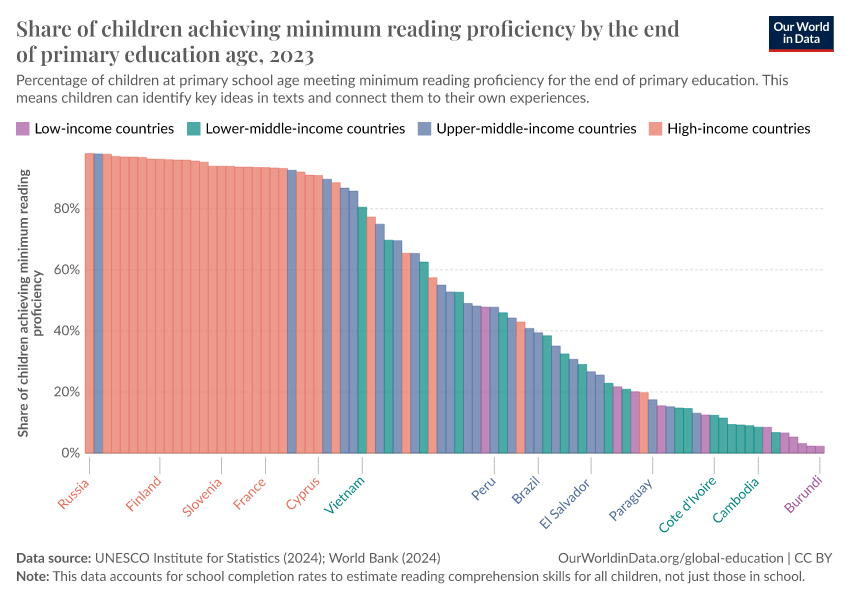Share of children achieving minimum reading proficiency by the end of primary age

What you should know about this indicator
- This indicator measures the share of children or students who achieve minimum proficiency in reading or mathematics by the end of a given education level (primary or lower secondary).
- Minimum proficiency in reading and mathematics is defined differently at each education level.
- At the end of primary education, minimum reading proficiency means students can identify key ideas in simple texts and connect them to their own experiences. In mathematics, it means demonstrating number sense and computation, basic measurement, interpreting simple graphs, spatial orientation, and number patterns.
- At the end of lower secondary, minimum reading proficiency means students can connect ideas across different types of texts, understand the author’s intent, and draw conclusions based on the text. In mathematics, it means applying computation skills, solving real-world problems, interpreting graphs and tables, and using algebraic representations.
- There are two types of estimates: one for all children in the age group, and one for students who are enrolled in school.
- Estimates for all children adjust for school completion and enrolment, offering a full population-level view — including those who dropped out or were never enrolled.
- Estimates for students reflect outcomes only among those still in school at the end of the education cycle.
- Data comes from international assessments such as TIMSS, PIRLS, or PISA, combined with completion and enrolment data from surveys or statistical models.
What you should know about this indicator
- This indicator measures the share of children or students who achieve minimum proficiency in reading or mathematics by the end of a given education level (primary or lower secondary).
- Minimum proficiency in reading and mathematics is defined differently at each education level.
- At the end of primary education, minimum reading proficiency means students can identify key ideas in simple texts and connect them to their own experiences. In mathematics, it means demonstrating number sense and computation, basic measurement, interpreting simple graphs, spatial orientation, and number patterns.
- At the end of lower secondary, minimum reading proficiency means students can connect ideas across different types of texts, understand the author’s intent, and draw conclusions based on the text. In mathematics, it means applying computation skills, solving real-world problems, interpreting graphs and tables, and using algebraic representations.
- There are two types of estimates: one for all children in the age group, and one for students who are enrolled in school.
- Estimates for all children adjust for school completion and enrolment, offering a full population-level view — including those who dropped out or were never enrolled.
- Estimates for students reflect outcomes only among those still in school at the end of the education cycle.
- Data comes from international assessments such as TIMSS, PIRLS, or PISA, combined with completion and enrolment data from surveys or statistical models.
Sources and processing
This data is based on the following sources
How we process data at Our World in Data
All data and visualizations on Our World in Data rely on data sourced from one or several original data providers. Preparing this original data involves several processing steps. Depending on the data, this can include standardizing country names and world region definitions, converting units, calculating derived indicators such as per capita measures, as well as adding or adapting metadata such as the name or the description given to an indicator.
At the link below you can find a detailed description of the structure of our data pipeline, including links to all the code used to prepare data across Our World in Data.
Reuse this work
- All data produced by third-party providers and made available by Our World in Data are subject to the license terms from the original providers. Our work would not be possible without the data providers we rely on, so we ask you to always cite them appropriately (see below). This is crucial to allow data providers to continue doing their work, enhancing, maintaining and updating valuable data.
- All data, visualizations, and code produced by Our World in Data are completely open access under the Creative Commons BY license. You have the permission to use, distribute, and reproduce these in any medium, provided the source and authors are credited.
Citations
How to cite this page
To cite this page overall, including any descriptions, FAQs or explanations of the data authored by Our World in Data, please use the following citation:
“Data Page: Share of children achieving minimum reading proficiency by the end of primary age”, part of the following publication: Hannah Ritchie, Veronika Samborska, Esteban Ortiz-Ospina, and Max Roser (2023) - “Global Education”. Data adapted from UNESCO Institute for Statistics. Retrieved from https://archive.ourworldindata.org/20250909-093708/grapher/share-of-children-achieving-minimum-reading-proficiency-by-the-end-of-primary-education.html [online resource] (archived on September 9, 2025).How to cite this data
In-line citationIf you have limited space (e.g. in data visualizations), you can use this abbreviated in-line citation:
UNESCO Institute for Statistics (2025) – with minor processing by Our World in DataFull citation
UNESCO Institute for Statistics (2025) – with minor processing by Our World in Data. “Share of children achieving minimum reading proficiency by the end of primary age” [dataset]. UNESCO Institute for Statistics, “UNESCO Institute for Statistics (UIS) - Education” [original data]. Retrieved January 7, 2026 from https://archive.ourworldindata.org/20250909-093708/grapher/share-of-children-achieving-minimum-reading-proficiency-by-the-end-of-primary-education.html (archived on September 9, 2025).